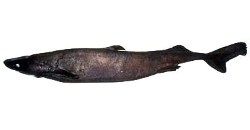Portuguese Shark

Common Name: Portuguese Shark
Scientific Name: Lamna nasus
Portuguese Shark : Description
The Portuguese shark was originally described as Centroscymnus coelolepis by Barbosa du Bocage and Brito Capello in 1864. This name is still accepted as scientifically valid. Scymnodon melas is a synonym that has occurred in past scientific literature to refer to this species. The genus name, Centroscymnus, is derived from the Greek "kentron" which means sting and from the Greek "skymnos" which means puppy. English language common names of Centroscymnus coelolepis include Portuguese shark, Portuguese dogfish and siki shark.
Portuguese Shark : Habitat
The range of the Portuguese shark is from Grand Banks, Newfoundland to Virginia in the western Atlantic Ocean. Portuguese sharks are benthic and live in deepwater, captured most frequently at depths of greater than 1,300 feet (400m). They have been taken from waters ranging from 886-12,000 feet (270-3,675 m) deep, at temperatures of 41-55 °F (5-13 °C). Females tend to inhabit deeper waters than males.
Portuguese Shark : Biology
The body of the Portuguese shark is moderately stout with a short, blunt snout. The gill arches are short. The mouth of this shark is slightly arched with thick lips and the presence of the upper and lower labial furrows. There is a very short, grooved spine barely sprotruding from the origin of each of the two equally small dorsal fins. The first dorsal fin origin is posterior to the broadly rounded pectoral fins. Adult Portuguese sharks are uniformly blackish brown, without any obvious black markings above the pelvic fins, ventrally on the caudal peduncle, or laterally on the upper caudal lobe. The average adult length is 27-39 inches (70-100 cm) with a maximum reported size of about 47 inches (120 cm). Males are smaller than females, reaching a maximum length of just over 35 inches (90 cm).
Portuguese Shark : Food
Benthic fishes, squids, octopods, and gastropods are among the prey items included in the diet of the Portuguese shark. They actively scavenge as well, as evidenced by marine mammals remains found in stomachs of this shark. They feed primarily at night.
Portuguese Shark : Reproduction
Portuguese sharks are ovoviviparous. Males reach sexual maturity at 27-30 inches (70-75 cm) total length (TL); mature females have been reported at 35-39 inches (90-100 cm) total length. Females ovulate mature ova measuring 50-60 mm in diameter. Embryos are nourished by the yolk; there is no placental attachment with the mother during development. Females give birth to 13-17 young, which are born at 11-12 inches (27-30 cm) in length.
Portuguese Shark : Conservation
Considered "Near Threatened" by the World Conservation Union (IUCN), the Portuguese shark has been commercially exploited in some regions of the world for squalene. The productivity of this species is likely to be low and further increases in catches should be a reason for concern.
 Deep Sea Crabs
Deep Sea Crabs